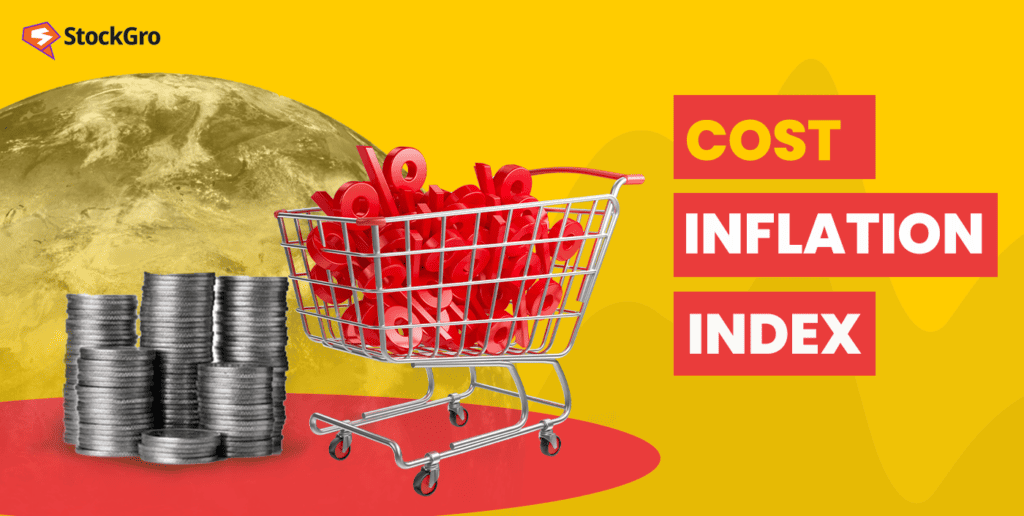
Do you often hear your parents and grandparents talking about how expensive today’s cost of living is?
Everything, from food grains to real estate, has grown multifolds today.
A litre of petrol was available at ₹26 in the year 2000. The same quantity is priced at ₹97 today.
The constant change in prices yearly has brought down the purchasing power. This concept of price increase and reduction in money value is called inflation.
The cost inflation index is one of the tools used to mitigate the negative implications of inflation on consumers.
What is the cost inflation index?
CII is an index used to calculate the impact of inflation on asset values and adjust them accordingly.
Inflation influences the current value of assets bought in the past. CII helps to estimate and adjust the differences between the original purchase price and current value.
You may also like: What are inflation-indexed bonds, and why should you care?
Why is the cost inflation index necessary?
Capital gains refer to profits earned by selling capital assets.
Section 112 of the Income Tax Act states that long-term capital gains are subject to taxes.
Hence, it is essential to ensure the correct computation of long-term capital gains.
Based on accounting principles, assets are recorded at the book value or the purchasing price. But, the sale of assets takes place at their present value.
So, the gap between the historical purchase price and the inflated current value is high.
This leads to higher capital gains, thereby increasing the amount of taxes to be paid.
In order to avoid this, the purchasing price of assets must include the component of inflation, too.
So, the historical price is adjusted based on the cost inflation index. It is then compared against the sale value of assets to arrive at accurate capital gains.
How is the cost inflation index determined?
The Government of India is responsible for publishing the cost inflation index every year on the Income Tax Department’s official website.
The Central Board of Direct Taxes (CBDT), a part of the Ministry of Finance, works with the Indian government to calculate the indices.
The government determines the CII, keeping the Consumer Price Index (CPI) as the base value.
CPI represents the rate of inflation in the prices of consumer goods.
Cost inflation index chart
Below is the latest index cost table published by the Indian Government:
| Financial year | Cost inflation index |
| 2001-02 (Base year) | 100 |
| 2002-03 | 105 |
| 2003-04 | 109 |
| 2004-05 | 113 |
| 2005-06 | 117 |
| 2006-07 | 122 |
| 2007-08 | 129 |
| 2008-09 | 137 |
| 2009-10 | 148 |
| 2010-11 | 167 |
| 2011-12 | 184 |
| 2012-13 | 200 |
| 2013-14 | 220 |
| 2014-15 | 240 |
| 2015-16 | 254 |
| 2016-17 | 264 |
| 2017-18 | 272 |
| 2018-19 | 280 |
| 2019-20 | 289 |
| 2020-21 | 301 |
| 2021-22 | 317 |
| 2022-23 | 331 |
| 2023-24 (provisional) | 348 |
Source: Cost Inflation Index
Base year in CII
The first year of CII is called the base year, with a base value of 100. CII for the following years are calculated as per the base year’s CII.
The initial base year decided by the government for CII was 1981-82. Due to difficulties in calculating values and taxes of assets purchased prior to 1981, the government moved the base year to 2001-02 with a base value of 100.
Application of CII in different scenarios
CII is used in adjusting the purchase price and improvement costs of assets.
- Cost inflation index in adjusting the purchase or acquisition cost
For assets purchased after the base year 2001-02:
Cost of acquisition upon indexing = (CI index for the year of sale * cost of acquisition or purchase) / CI index of the year of purchase
For assets purchased before the base year 2001-02:
Cost of acquisition upon indexing = (CI index for the year of sale * cost of acquisition or purchase) / CI index of the base year 2001-02
Also Read: Everything you need to know about deflation
- Cost inflation index in adjusting the improvement cost
Improvement cost is the cost spent on adding additional features to the asset to improve its functionalities.
Cost of improvement upon indexing = (CI index for the year of sale * cost of improvement) / CI index of the improvement year
Points to consider while calculating indexed costs for capital gains:
- Asset improvement costs incurred before 2001 are not considered while indexing.
- If an individual inherits an ancestral property through a will, the year of inheriting the property is considered instead of the year of purchase.
- The Government of India removed the option of indexing debt funds from FY 2023-2024. However, it is still applicable to Sovereign Gold Bonds (SGB) by RBI and capital-indexed bonds.
Examples
Let us now look at a few scenarios to calculate indexed costs:
- Mr A purchased a house in the year 2005 for ₹ 15,00,000. He decided to sell the house in 2020. Calculate the acquisition cost after indexing.
CII in the year of purchase = 117 CII in the year of sale = 301 Indexed cost of acquisition = (301 * 15,00,000) / 117 = ₹ 38,58,974 Mr B purchased a site in the year 1990 for ₹3,00,000. He decided to sell it in 2015. Calculate the acquisition cost after indexing. The initial purchase of the property is before the base year. Hence, we consider CII for the base year instead of the purchasing year. CII in the base year = 100 CII in the year of sale = 254 Indexed cost = (254 * 3,00,000) / 100 = ₹ 7,62,000
Bottomline
In the first example of Mr A, let us assume he does not index his acquisition costs. Mr A decides to sell his house for ₹ 70,00,000. His capital gains would be ₹ 55,00,000 (70,00,000 – 15,00,000).
A tax rate of 20% is charged on capital gains, so Mr A incurs a tax expense of ₹ 11,00,000.
If A decides to index his cost, his capital gains would be ₹ 31,41,026 (70,00,000 – 38,58,974). He would incur a tax of ₹ 6,28,205.
So, adjusting the purchase price of assets is essential to make a fair comparison against the sale value. The CII is a significant tool that aids in capital gains indexing and helps in saving taxes.

